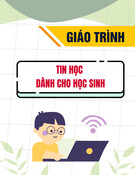
Digital Image Formats
Ho Dac Hung
1

Contents
•Color representation
•Spatial-domain formats
•Transform-domain formats
2

1. Color Representation
•Visible light is a superposition of
electromagnetic waves with wavelengths
spanning the interval between approximately
380 nm and 750 nm.
•Each color can be associated with the spectral
density function P (λ), which describes the
amount of energy present at wavelength λ.
3

1. Color Representation
4

1. Color Representation
•Denoting the amount of each color as R, G,
and B, where each number is from the interval
[0, 1] (zero intensity to full intensity), each
color can be represented as a three-
dimensional vector in the RGB color cube (R,
G, B) ∈ [0, 1]3.
•Hardware systems that emit light are usually
modeled as additive.
5












![Đề thi Excel: Tổng hợp [Năm] mới nhất, có đáp án, chuẩn nhất](https://cdn.tailieu.vn/images/document/thumbnail/2025/20251103/21139086@st.hcmuaf.edu.vn/135x160/61461762222060.jpg)


![Bài tập Tin học đại cương [kèm lời giải/ đáp án/ mới nhất]](https://cdn.tailieu.vn/images/document/thumbnail/2025/20251018/pobbniichan@gmail.com/135x160/16651760753844.jpg)
![Bài giảng Nhập môn Tin học và kỹ năng số [Mới nhất]](https://cdn.tailieu.vn/images/document/thumbnail/2025/20251003/thuhangvictory/135x160/33061759734261.jpg)
![Tài liệu ôn tập Lý thuyết và Thực hành môn Tin học [mới nhất/chuẩn nhất]](https://cdn.tailieu.vn/images/document/thumbnail/2025/20251001/kimphuong1001/135x160/49521759302088.jpg)


![Trắc nghiệm Tin học cơ sở: Tổng hợp bài tập và đáp án [mới nhất]](https://cdn.tailieu.vn/images/document/thumbnail/2025/20250919/kimphuong1001/135x160/59911758271235.jpg)


![Giáo trình Lý thuyết PowerPoint: Trung tâm Tin học MS [Chuẩn Nhất]](https://cdn.tailieu.vn/images/document/thumbnail/2025/20250911/hohoainhan_85/135x160/42601757648546.jpg)


